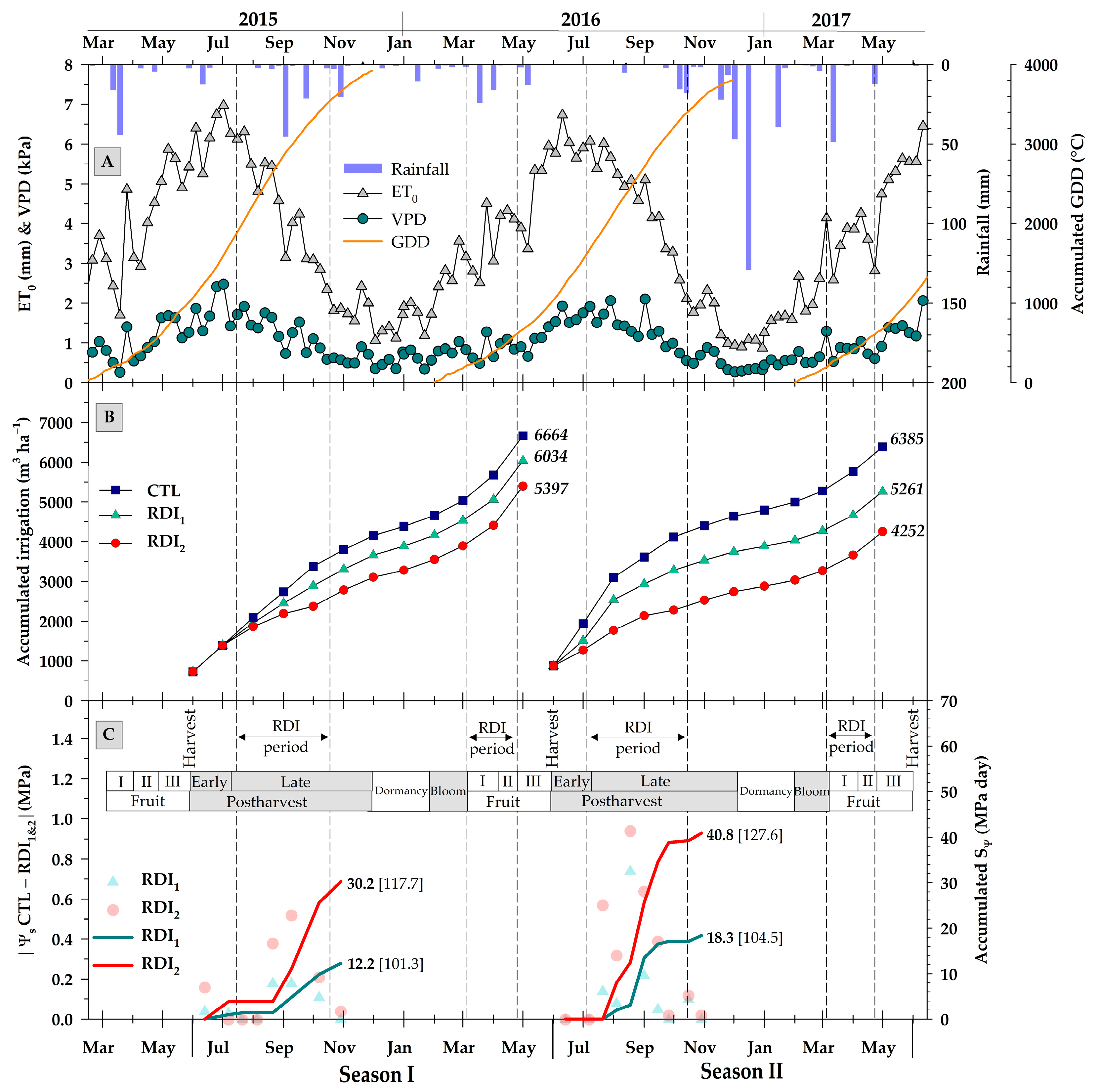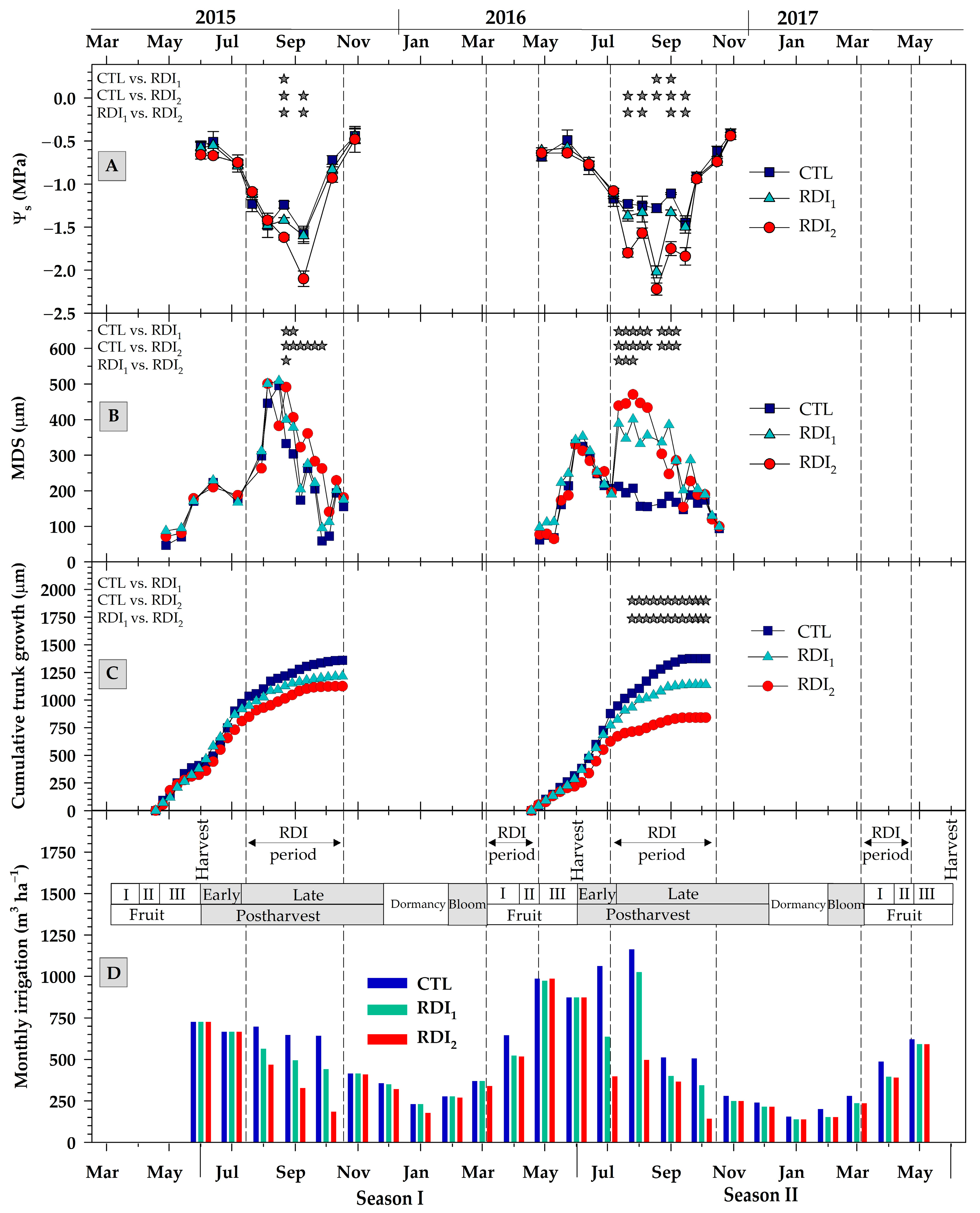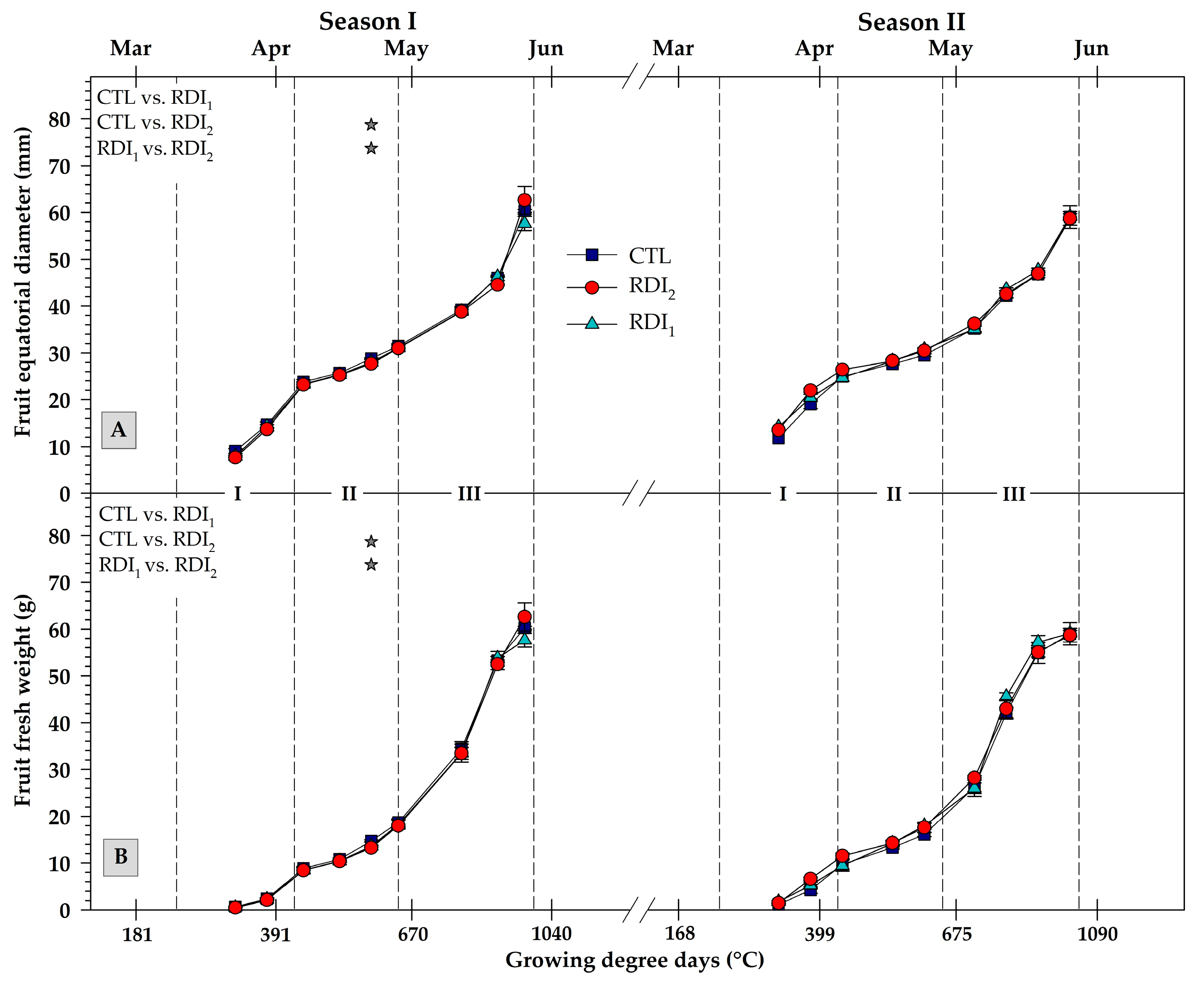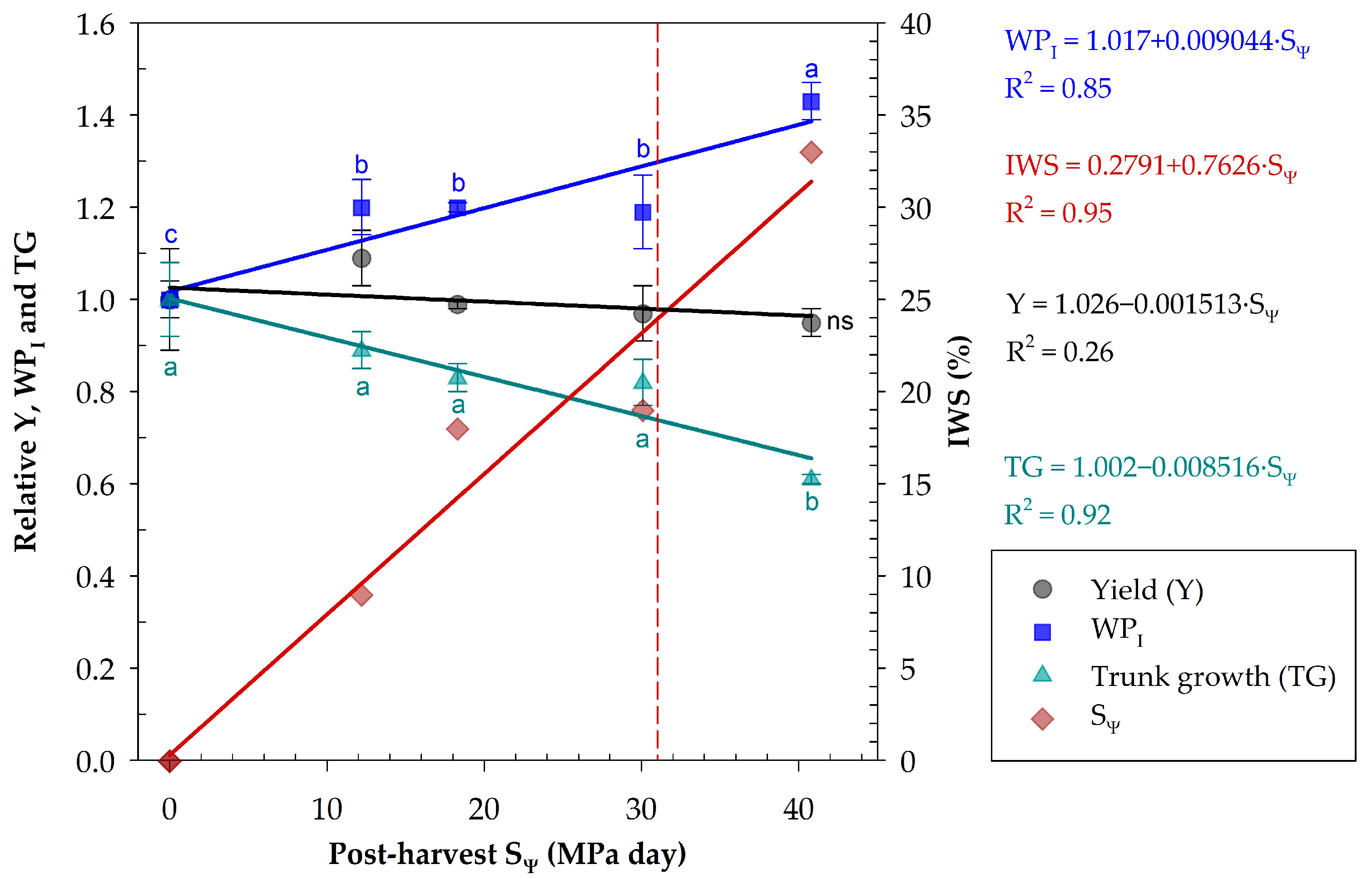Threshold Values of Plant Water Status for Scheduling Deficit Irrigation in Early Apricot Trees
Abstract
:1. Introduction
2. Materials and Methods
2.1. Experimental Site and Design
- Control (CTL), irrigated at ~100% of the crop evapotranspiration (ETc) during the entire crop cycle.
- Regulated deficit irrigation 1 (RDI1), irrigated as CTL, except during fruit growth stages I–II when irrigation was reduced by 20% of CTL, and from July onwards in late post-harvest, when an irrigation threshold of approximately −1.5 MPa of stem water potential (Ψs) was used, corresponding to a moderate water stress [10].
- Regulated deficit irrigation 2 (RDI2), irrigated as CTL, except during fruit growth stages I–II when irrigation was reduced by 20% of CTL, and from July onwards in late post-harvest, when an irrigation threshold of approximately −2.0 MPa of Ψs was used, corresponding to a severe water stress [10].
2.2. Weather Conditions
2.3. Plant Water Status
2.4. Yield Parameters and Water Productivity
2.5. Fruit Quality Traits
2.6. Statistical Analysis
3. Results
3.1. Weather and Irrigation
3.2. Plant Water Status
3.3. Fruit and Trunk Growth
3.4. Yield and Irrigation Water Productivity
3.5. Fruit Quality
3.6. Effect of Water Stress on Crop Agronomic Response and Water Productivity
4. Discussion
5. Conclusions
Author Contributions
Funding
Data Availability Statement
Acknowledgments
Conflicts of Interest
References
- Torrecillas, A.; Corell, M.; Galindo, A.; Pérez-López, D.; Memmi, H.; Rodríguez, P.; Cruz, Z.N.; Centeno, A.; Intrigliolo, D.S.; Moriana, A. Agronomical Effects of Deficit Irrigation in Apricot, Peach, and Plum Trees. In Water Scarcity and Sustainable Agriculture in Semiarid Environment: Tools, Strategies, and Challenges for Woody Crops; Garcia-Tejero, I., Duran, V., Eds.; Elsevier: London, UK, 2018; pp. 87–109. [Google Scholar]
- Ruiz-Sánchez, M.C.; Domingo, R.; Torrecillas, A.; Pérez-Pastor, A. Water Stress Preconditioning to Improve Drought Resistance in Young Apricot Plants. Plant Sci. 2000, 156, 245–251. [Google Scholar] [CrossRef]
- CARM. Estadística Agraria de Murcia 2019/20, 1st ed.; Comunidad Autónoma de la Región de Murcia, Ed.; Consejería de Agua, Agricultura, Ganadería, Pesca y Medio Ambiente: Murcia, Spain, 2020; Volume Informe 28. [Google Scholar]
- Llácer, G. La elección de variedades de albaricoque en la Comunidad Valenciana. Comunitat Valencia. Agrar. 2000, 17, 26–32. [Google Scholar]
- Torelló-Sentelles, H.; Franzke, C.L.E. Drought Impact Links to Meteorological Drought Indicators and Predictability in Spain. Hydrol. Earth Syst. Sci. 2022, 26, 1821–1844. [Google Scholar] [CrossRef]
- Vargas, J.; Paneque, P. Challenges for the Integration of Water Resource and Drought-Risk Management in Spain. Sustainability 2019, 11, 308. [Google Scholar] [CrossRef]
- Vicente-Serrano, S.M.; McVicar, T.R.; Miralles, D.G.; Yang, Y.; Tomas-Burguera, M. Unraveling the Influence of Atmospheric Evaporative Demand on Drought and Its Response to Climate Change. Wiley Interdiscip. Rev. Clim. Chang. 2020, 11, e632. [Google Scholar] [CrossRef]
- Vicente-Serrano, S.M.; Domínguez-Castro, F.; Reig, F.; Beguería, S.; Tomas-Burguera, M.; Latorre, B.; Peña-Angulo, D.; Noguera, I.; Rabanaque, I.; Luna, Y.; et al. A near Real-Time Drought Monitoring System for Spain Using Automatic Weather Station Network. Atmos. Res. 2022, 271, 106095. [Google Scholar] [CrossRef]
- Steduto, P.; Hsiao, T.C.; Fereres, E.; Raes, D. Crop Yield Response to Water. In FAO Irrigation and Drainage Paper No 66; Cambridge University Press: Cambridge, UK, 2012. [Google Scholar]
- Pérez-Pastor, A.; Domingo, R.; Torrecillas, A.; Ruiz-Sánchez, M.C. Response of Apricot Trees to Deficit Irrigation Strategies. Irrig. Sci. 2009, 27, 231–242. [Google Scholar] [CrossRef]
- Torrecillas, A.; Galego, R.; Pérez-Pastor, A.; Ruiz-Sánchez, M.C. Gas Exchange and Water Relations of Young Apricot Plants under Drought Conditions. J. Agric. Sci. 1999, 132, 445–452. [Google Scholar] [CrossRef]
- Losciale, P.; Gaeta, L.; Corsi, M.; Galeone, C.; Tarricone, L.; Leogrande, R.; Stellacci, A.M. Physiological Responses of Apricot and Peach Cultivars under Progressive Water Shortage: Different Crop Signals for Anisohydric and Isohydric Behaviours. Agric. Water Manag. 2023, 286, 108384. [Google Scholar] [CrossRef]
- Chalmers, D.J.; Mitchell, P.D.; van Heek, L. Control of Peach Tree Growth and Productivity by Regulated Water Supply, Tree Density, and Summer Pruning [Trickle Irrigation]. J. Am. Soc. Hortic. Sci. 1981, 106, 307–312. [Google Scholar] [CrossRef]
- De la Rosa, J.M.; Conesa, M.R.; Domingo, R.; Aguayo, E.; Falagán, N.; Pérez-Pastor, A. Combined Effects of Deficit Irrigation and Crop Level on Early Nectarine Trees. Agric. Water Manag. 2016, 170, 120–132. [Google Scholar] [CrossRef]
- De la Rosa, J.M.; Domingo, R.; Gómez-Montiel, J.; Pérez-Pastor, A. Implementing Deficit Irrigation Scheduling through Plant Water Stress Indicators in Early Nectarine Trees. Agric. Water Manag. 2015, 152, 207–216. [Google Scholar] [CrossRef]
- Blanco, V.; Torres-Sánchez, R.; Blaya-Ros, P.J.; Pérez-Pastor, A.; Domingo, R. Vegetative and Reproductive Response of ‘Prime Giant’ Sweet Cherry Trees to Regulated Deficit Irrigation. Sci. Hortic. 2019, 249, 478–489. [Google Scholar] [CrossRef]
- Blanco, V.; Domingo, R.; Pérez-Pastor, A.; Blaya-Ros, P.J.; Torres-Sánchez, R. Soil and Plant Water Indicators for Deficit Irrigation Management of Field-Grown Sweet Cherry Trees. Agric. Water Manag. 2018, 208, 83–94. [Google Scholar] [CrossRef]
- Ruiz-Sánchez, M.C.; Abrisqueta, I.; Conejero, W.; Vera, J. Deficit Irrigation Management in Early-Maturing Peach Crop. In Water Scarcity and Sustainable Agriculture in Semiarid Environment: Tools, Strategies, and Challenges for Woody Crops; Academic Press: Cambridge, MA, USA, 2018; pp. 111–129. [Google Scholar] [CrossRef]
- Naor, A. Irrigation Scheduling of Peach-Deficit Irrigation at Different Phenological Stages and Water Stress Assessment. Acta Hortic. 2006, 713, 339–349. [Google Scholar] [CrossRef]
- Girona, J.; Gelly, M.; Mata, M.; Arbonès, A.; Rufat, J.; Marsal, J.; Arbonè, A.; Rufat, J.; Marsal, J. Peach Tree Response to Single and Combined Deficit Irrigation Regimes in Deep Soils. Agric. Water Manag. 2005, 72, 97–108. [Google Scholar] [CrossRef]
- Vera, J.; Abrisqueta, I.; Abrisqueta, J.M.; Ruiz-Sánchez, M.C. Effect of Deficit Irrigation on Early-Maturing Peach Tree Performance. Irrig. Sci. 2013, 31, 747–757. [Google Scholar] [CrossRef]
- Temnani, A.; Berríos, P.; Zapata-García, S.; Pérez-Pastor, A. Deficit Irrigation Strategies of Flat Peach Trees under Semi-Arid Conditions. Agric. Water Manag. 2023, 287, 108464. [Google Scholar] [CrossRef]
- Intrigliolo, D.S.; Ballester, C.; Castel, J.R. Carry-over Effects of Deficit Irrigation Applied over Seven Seasons in a Developing Japanese Plum Orchard. Agric. Water Manag. 2013, 128, 13–18. [Google Scholar] [CrossRef]
- Girona, J.; Mata, M.; Marsal, J. Regulated Deficit Irrigation during the Kernel-Filling Period and Optimal Irrigation Rates in Almond. Agric. Water Manag. 2005, 75, 152–167. [Google Scholar] [CrossRef]
- Goldhamer, D.A.; Viveros, M.; Salinas, M. Regulated Deficit Irrigation in Almonds: Effects of Variations in Applied Water and Stress Timing on Yield and Yield Components. Irrig. Sci. 2006, 24, 101–114. [Google Scholar] [CrossRef]
- Egea, G.; Nortes, P.A.; Domingo, R.; Baille, A.; Pérez-Pastor, A.; González-Real, M.M. Almond Agronomic Response to Long-Term Deficit Irrigation Applied since Orchard Establishment. Irrig. Sci. 2013, 31, 445–454. [Google Scholar] [CrossRef]
- Torrecillas, A.; Domingo, R.; Galego, R.; Ruiz-Sánchez, M.C. Apricot Tree Response to Withholding Irrigation at Different Phenological Periods. Sci. Hortic. 2000, 85, 201–215. [Google Scholar] [CrossRef]
- Ezzat, A.; Salama, A.-M.; Szabó, S.; Yaseen, A.-A.; Molnár, B.; Holb, I.-J. Deficit Irrigation Strategies on Tree Physiological and Chemical Properties: Treatment Effects, Prediction Based Model Analyses and Inter-Correlations. Agronomy 2021, 11, 1361. [Google Scholar] [CrossRef]
- Allen, R.G.; Pereira, L.S.; Raes, D.; Smith, M. Crop Evapotranspiration; FAO 56; FAO: Rome, Italy, 1998; p. 300. [Google Scholar]
- Pérez-Pastor, A.; Ruiz-Sánchez, M.C.; Domingo, R. Effects of Timing and Intensity of Deficit Irrigation on Vegetative and Fruit Growth of Apricot Trees. Agric. Water Manag. 2014, 134, 110–118. [Google Scholar] [CrossRef]
- de la Rosa, J.M.; Dodd, I.; Domingo, R.; Pérez-Pastor, A. Early Morning Fluctuations in Trunk Diameter Are Highly Sensitive to Water Stress in Nectarine Trees. Irrig. Sci. 2016, 34, 117–128. [Google Scholar] [CrossRef]
- Jones, H.G. Irrigation Scheduling: Advantages and Pitfalls of Plant-Based Methods. J. Appl. Bot. 2004, 55, 2427–2436. [Google Scholar] [CrossRef]
- Ortuño, M.F.; Brito, J.J.; García-Orellana, Y.; Conejero, W.; Torrecillas, A. Maximum Daily Trunk Shrinkage and Stem Water Potential Reference Equations for Irrigation Scheduling of Lemon Trees. Irrig. Sci. 2009, 27, 121–127. [Google Scholar] [CrossRef]
- Egea, G.; Pagán, E.; Baille, A.; Domingo, R.; Nortes, P.A.; Pérez-Pastor, A. Usefulness of Establishing Trunk Diameter Based Reference Lines for Irrigation Scheduling in Almond Trees. Irrig. Sci. 2009, 27, 431–441. [Google Scholar] [CrossRef]
- Pagán, E.; Robles, J.M.; Temnani, A.; Berríos, P.; Botía, P.; Pérez-Pastor, A. Effects of Water Deficit and Salinity Stress on Late Mandarin Trees. Sci. Total Environ. 2022, 803, 150109. [Google Scholar] [CrossRef]
- Myers, B.J. Water Stress Integral—A Link between Short-Term Stress and Long-Term Growth. Tree Physiol. 1988, 4, 315–323. [Google Scholar] [CrossRef] [PubMed]
- Berríos, P.; Temnani, A.; Zapata, S.; Forcén-Muñoz, M.; Franco, J.A.; Pérez-Pastor, A. Sensitivity to Water Deficit of the Second Stage of Fruit Growth in Late Mandarin Trees. Irrig. Sci. 2023, 41, 35–47. [Google Scholar] [CrossRef]
- Richardson, E.A.; Seeley, S.D.; Walker, D.R.; Anderson, J.L.; Ashcroft, G.L. Pheno-Climatography of Spring Peach Bud Development. HortScience 1975, 10, 236–237. [Google Scholar] [CrossRef]
- Milošević, T.; Milošević, N. Behavior of Apricot (Prunus armeniaca L.) under Climate Change. In Cultivation for Climate Change Resilience: Temperate Fruit Trees; Abul-Soad, A.A., Al-Khayri, J.M., Eds.; CRC Press: Boca Raton, FL, USA, 2023; Volume 2, pp. 234–256. ISBN 9781003351153. [Google Scholar]
- Uriu, K. Effect of Post-Harvest Soil Moisture Depletion on Subsequent Yield of Apricot. Proc. Am. Soc. Hortic. Sci. 1964, 84, 93–97. [Google Scholar]
- Ruiz-Sánchez, M.C.; Egea, J.; Galego, R.; Torrecillas, A. Floral Biology of ‘Bulida’ Apricot Trees Subjected to Postharvest Drought Stress. Ann. Appl. Biol. 1999, 135, 523–528. [Google Scholar] [CrossRef]
- AEMET. Servicios Climáticos: Valores Climatológicos Normales. Available online: https://www.aemet.es/es/serviciosclimaticos/datosclimatologicos/valoresclimatologicos (accessed on 11 October 2021).
- Espada, J.L. Abonado de Los Frutos Caducifolios. In Guía Práctica de la Fertilización Racional de los Cultivos en España; Ministerio de Medio Ambiente y Medio Rural y Marino, Ed.; Secretaría General Técnica del Ministerio de Medio Ambiente y Medio Rural y Marino: Madrid, Spain, 2005; Volume II, pp. 205–212. ISBN 978-84-491-0997-3. [Google Scholar]
- Gómez-Aparisi, J. Respuesta al Riego de Las Especies Frutales de Hueso: Albaricoque, Ciruelo y Cerezo. Frutic. Prof. 1990, 30, 106–113. [Google Scholar]
- SIAM. Visor Del Sistema de Información Agraria de Murcia. Available online: http://siam.imida.es/apex/f?p=101:41:1216327970564392 (accessed on 30 June 2015).
- Murray, F.W. On the Computation of Saturation Vapor Pressure. J. Appl. Meteorol. 1967, 6, 203–204. [Google Scholar] [CrossRef]
- Marra, F.P.; Inglese, P.; DeJong, T.M.; Johnson, R.S. Thermal Time Requirement and Harvest Time Forecast for Peach Cultivars with Different Fruit Development Periods. Acta Hortic. 2002, 592, 523–529. [Google Scholar] [CrossRef]
- Goldhamer, D.; Fereres, E. Irrigation Scheduling of Almond Trees with Trunk Diameter Sensors. Irrig. Sci. 2003, 23, 11–19. [Google Scholar] [CrossRef]
- Fernández, J.E.; Alcon, F.; Diaz-Espejo, A.; Hernandez-Santana, V.; Cuevas, M.V. Water Use Indicators and Economic Analysis for On-Farm Irrigation Decision: A Case Study of a Super High Density Olive Tree Orchard. Agric. Water Manag. 2020, 237, 106074. [Google Scholar] [CrossRef]
- Rodrigues, G.C.; Pereira, L.S. Assessing Economic Impacts of Deficit Irrigation as Related to Water Productivity and Water Costs. Biosyst. Eng. 2009, 103, 536–551. [Google Scholar] [CrossRef]
- Dastane, N.G. Effective Rainfall in Irrigated Agriculture. FAO Irrig. Drain. Eng. 1978, 4, 25. [Google Scholar]
- Artés, F.; Escriche, A.J.; Martínez, J.A.; Marín, J.G. Quality Factors in Four Varieties of Melon (Cucumis melo L.). J. Food Qual. 1993, 16, 91–100. [Google Scholar] [CrossRef]
- Jayasena, V.; Cameron, I. °Brix/Acid Ratio as a Predictor of Consumer Acceptability of Crimson Seedless Table Grapes. J. Food Qual. 2008, 31, 736–750. [Google Scholar] [CrossRef]
- Levene, H. Robust Tests for Equality of Variances. In Contributions to Probability and Statistics; Olkin, I., Ed.; Stanford University Press: Palo Alto, CA, USA, 1960; pp. 278–292. [Google Scholar]
- O’Brien, R.G. A Simple Test for Variance Effects in Experimental Designs. Psychol. Bull. 1981, 89, 570–574. [Google Scholar] [CrossRef]
- Yitnosumarto, S.; O’Neill, M.E. On Levene’s Test of Variance Homogeneity. Austrian J. Stat. 1986, 28, 230–241. [Google Scholar] [CrossRef]
- di Renzo, J.A.; Casanoves, F.; Balzarini, M.G.; Gonzalez, L.; Tablada, M.; Robledo, C.W. Infostat—Software Estadístico. Available online: https://www.infostat.com.ar (accessed on 15 April 2022).
- Girona, J.; Marsal, J.; Mata, M.; Arbonés, A.; Mata, A. The Combined Effect of Fruit Load and Water Stress in Different Peach Fruit Growth Stages (Prunus persica L). Acta Hortic. 2002, 584, 149–152. [Google Scholar] [CrossRef]
- Thakur, A.; Singh, Z. Responses of ‘Spring Bright’ and ‘Summer Bright’ Nectarines to Deficit Irrigation: Fruit Growth and Concentration of Sugars and Organic Acids. Sci. Hortic. 2012, 135, 112–119. [Google Scholar] [CrossRef]
- Ruiz-Sanchez, M.C.; Domingo, R.; Castel, J.R. Review. Deficit Irrigation in Fruit Trees and Vines in Spain. Span. J. Agric. Res. 2010, 8, 5–20. [Google Scholar] [CrossRef]
- Pérez-Pastor, A.; Ruiz-Sánchez, M.C.; Domingo, R.; Torrecillas, A. Growth and Phenological Stages of Búlida Apricot Trees in South-East Spain. Agronomie 2004, 24, 93–100. [Google Scholar] [CrossRef]
- Lakso, A.N.; Santiago, M.; Stroock, A.D. Monitoring Stem Water Potential with an Embedded Microtensiometer to Inform Irrigation Scheduling in Fruit Crops. Horticulturae 2022, 8, 1207. [Google Scholar] [CrossRef]
- Shackel, K.; Ahmadi, H.; Biasi, W.; Buchner, R.; Goldhamer, D.; Gurusinghe, S.; Hasey, J.; Kester, D.; Krueger, B.; Lampinen, B.; et al. Plant Water Status as an Index of Irrigation Need in Deciduous Fruit Trees. HortTechnology 1997, 7, 23–29. [Google Scholar] [CrossRef]
- Naor, A. Midday Stem Water Potential as a Plant Water Stress Indicator for Irrigation Scheduling in Fruit Trees. Acta Hortic. 2000, 537, 447–454. [Google Scholar] [CrossRef]
- Ortuño, M.F.; Conejero, W.; Moreno, F.; Moriana, A.; Intrigliolo, D.S.; Biel, C.; Mellisho, C.D.; Pérez-Pastor, A.; Domingo, R.; Ruiz-Sánchez, M.C.; et al. Could Trunk Diameter Sensors Be Used in Woody Crops for Irrigation Scheduling? A Review of Current Knowledge and Future Perspectives. Agric. Water Manag. 2010, 97, 1–11. [Google Scholar] [CrossRef]




| Season/ Treatment | Yield | Fruit Load | Fruit Weight | |||
|---|---|---|---|---|---|---|
| (kg Tree−1) | (Fruits Tree−1) | (g FW) | (kg m−3) | (kg m−3) | ||
| 2015/16 | CTL | 123.2 | 2041 | 60.3 | 4.40 | 3.75 |
| RDI1 | 134.5 | 2336 | 57.6 | 5.31 | 4.46 | |
| RDI2 | 119.2 | 1923 | 62.6 | 5.26 | 4.33 | |
| 2016/17 | CTL | 101.0 | 1711 | 59.0 | 3.77 c | 2.73 c |
| RDI1 | 99.7 | 1686 | 59.1 | 4.51 b | 3.09 b | |
| RDI2 | 95.9 | 1636 | 58.7 | 5.37 a | 3.43 a | |
| Season (S) | *** | ** | ns | ns | *** | |
| Treatment (T) | ns | ns | ns | *** | * | |
| S × T | ns | ns | ns | ns | ns | |
| Season/ Treatment | Firmness | TA | TSS | MI | |
|---|---|---|---|---|---|
| (kg cm−2) | (%) | (°Brix) | (TSS/TA) | ||
| 2015/16 | CTL | 7.4 | 1.29 | 10.1 | 7.8 |
| RDI1 | 7.3 | 1.26 | 10.5 | 8.0 | |
| RDI2 | 7.2 | 1.27 | 10.2 | 8.3 | |
| 2016/17 | CTL | 7.3 | 1.24 | 9.80 | 7.9 |
| RDI1 | 7.1 | 1.23 | 10.3 | 8.4 | |
| RDI2 | 6.8 | 1.24 | 9.80 | 7.8 | |
| Season (S) | ns | ns | ns | ns | |
| Treatment (T) | ns | ns | ns | ns | |
| S × T | ns | ns | ns | ns | |
Disclaimer/Publisher’s Note: The statements, opinions and data contained in all publications are solely those of the individual author(s) and contributor(s) and not of MDPI and/or the editor(s). MDPI and/or the editor(s) disclaim responsibility for any injury to people or property resulting from any ideas, methods, instructions or products referred to in the content. |
© 2023 by the authors. Licensee MDPI, Basel, Switzerland. This article is an open access article distributed under the terms and conditions of the Creative Commons Attribution (CC BY) license (https://creativecommons.org/licenses/by/4.0/).
Share and Cite
Temnani, A.; Berríos, P.; Zapata-García, S.; Espinosa, P.J.; Pérez-Pastor, A. Threshold Values of Plant Water Status for Scheduling Deficit Irrigation in Early Apricot Trees. Agronomy 2023, 13, 2344. https://doi.org/10.3390/agronomy13092344
Temnani A, Berríos P, Zapata-García S, Espinosa PJ, Pérez-Pastor A. Threshold Values of Plant Water Status for Scheduling Deficit Irrigation in Early Apricot Trees. Agronomy. 2023; 13(9):2344. https://doi.org/10.3390/agronomy13092344
Chicago/Turabian StyleTemnani, Abdelmalek, Pablo Berríos, Susana Zapata-García, Pedro J. Espinosa, and Alejandro Pérez-Pastor. 2023. "Threshold Values of Plant Water Status for Scheduling Deficit Irrigation in Early Apricot Trees" Agronomy 13, no. 9: 2344. https://doi.org/10.3390/agronomy13092344
APA StyleTemnani, A., Berríos, P., Zapata-García, S., Espinosa, P. J., & Pérez-Pastor, A. (2023). Threshold Values of Plant Water Status for Scheduling Deficit Irrigation in Early Apricot Trees. Agronomy, 13(9), 2344. https://doi.org/10.3390/agronomy13092344







